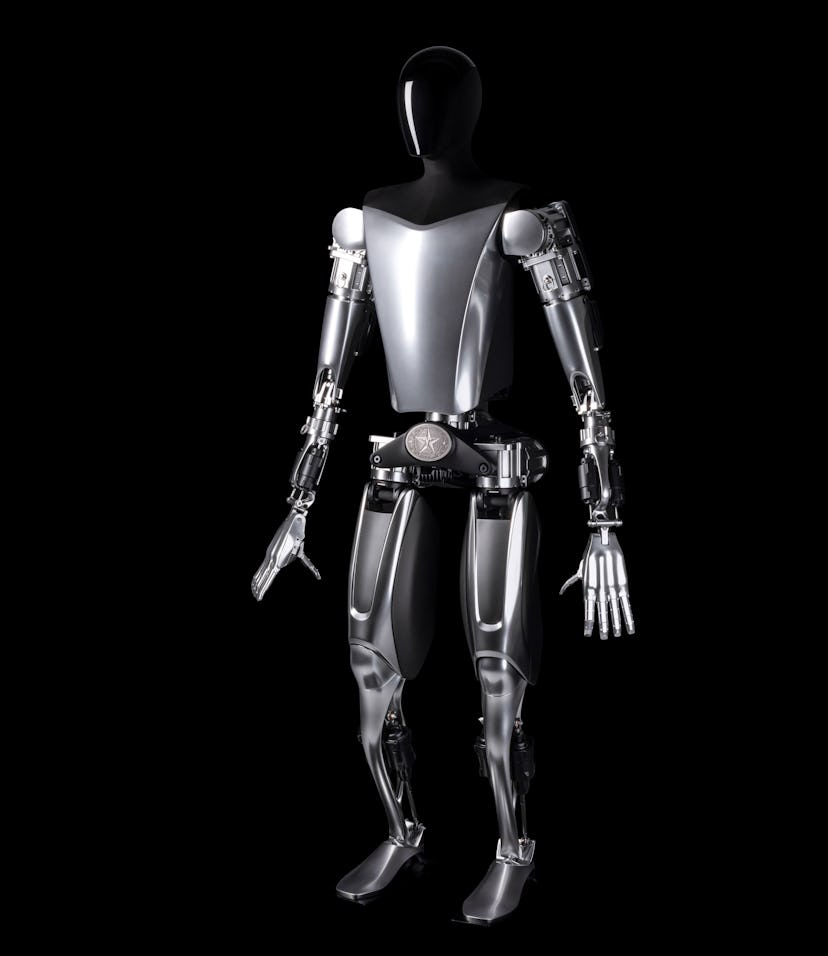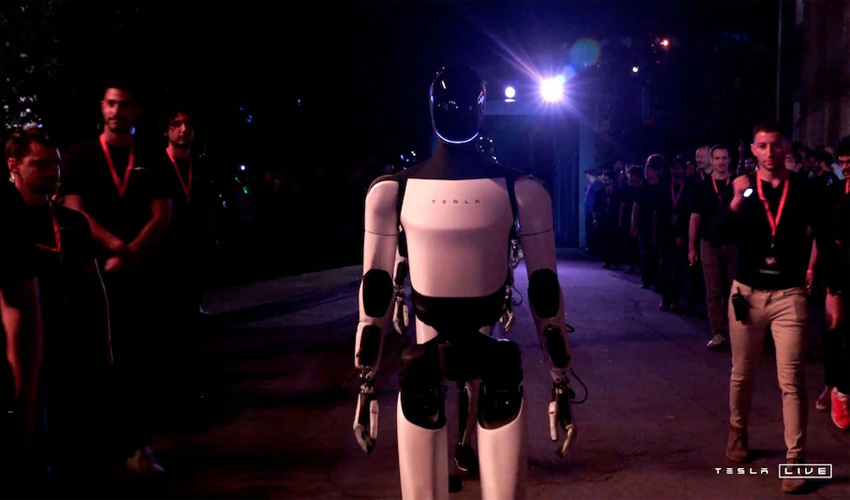Elon Musk's Vision For Tesla's Optimus Robots: Why They Resemble "Creepy Robots"
Elon Musk's vision for the future of robotics is both audacious and fascinating. Tesla's Optimus robots, crafted to revolutionize industries and everyday life, have ignited widespread curiosity and debate. Their resemblance to the "creepy robots" from a Will Smith movie has sparked discussions about design choices and their implications. In this article, we explore Musk's rationale behind the humanoid design of the Optimus robots, examining the underlying technology, purpose, and potential societal impact.
As one of the most innovative figures in modern technology, Elon Musk has consistently pushed boundaries. His ventures, including SpaceX and Tesla, have set new benchmarks in their respective fields. The introduction of Tesla's Optimus robots represents yet another leap forward in artificial intelligence and robotics, promising to redefine how humans interact with machines and technology.
This article seeks to provide a comprehensive analysis of Musk's perspective on why Tesla's Optimus robots bear similarities to the "creepy robots" from a Will Smith movie. By exploring the design philosophy, technological foundations, and societal implications, we aim to offer a thorough understanding of this groundbreaking innovation and its potential to shape the future.
Read also:Sheryl Crow Hosts Varietys Power Of Women Nashville Event
Table of Contents
- Elon Musk's Biography
- Overview of Tesla's Optimus Robots
- Design Choices Behind the Humanoid Form
- The Will Smith Movie Reference
- Artificial Intelligence Technology in Optimus
- Societal Implications of Humanoid Robots
- Challenges in Developing Humanoid Robots
- Future Directions for Tesla's Robotics
- Economic Benefits of Optimus Robots
- Ethical Considerations in Robotics
Elon Musk's Biography
Elon Musk, born on June 28, 1971, in Pretoria, South Africa, is a visionary entrepreneur and engineer renowned for his groundbreaking work in technology. Musk has founded and led several companies that have transformed industries. Below is a concise overview of his life and achievements:
Key Details of Elon Musk
| Full Name | Elon Reeve Musk |
|---|---|
| Date of Birth | June 28, 1971 |
| Place of Birth | Pretoria, South Africa |
| Education | University of Pennsylvania (B.S. in Physics and B.A. in Economics) |
| Companies Founded | SpaceX, Tesla, Neuralink, The Boring Company |
Musk's journey from a young programmer to a global influencer has been characterized by bold decisions and an unwavering commitment to innovation. His work with Tesla and SpaceX has positioned him as a leader in sustainable energy and space exploration, paving the way for a future driven by cutting-edge technology.
Overview of Tesla's Optimus Robots
Tesla's Optimus robots mark a significant advancement in the field of robotics. These humanoid machines are designed to execute a wide range of tasks, from manufacturing processes to household chores. Musk envisions Optimus as a tool to amplify human productivity and enhance quality of life. By leveraging advanced robotics and artificial intelligence, Tesla aims to create machines that seamlessly integrate into human environments.
Key Features of Optimus
- Humanoid design for versatility in task execution across diverse settings.
- Powered by Tesla's cutting-edge AI and neural network technology, ensuring precision and adaptability.
- Capable of operating in various environments, including industrial facilities and domestic spaces.
- Designed to be cost-effective and scalable, making them accessible for widespread adoption.
Musk argues that the humanoid form of Optimus allows it to interact effortlessly with human-made environments, making it highly adaptable to different tasks and scenarios.
Design Choices Behind the Humanoid Form
The decision to design Optimus as a humanoid robot was not arbitrary. Musk explains that the human form offers several distinct advantages:
- Compatibility with Human Environments: Humanoid robots can navigate spaces designed for humans, such as offices and homes, without requiring significant modifications, ensuring seamless integration.
- Versatility in Task Execution: A humanoid design enables the robot to perform a wide array of tasks, from heavy lifting to delicate operations, enhancing its utility in various contexts.
- Familiarity and Relatability: A humanoid appearance may help users feel more comfortable interacting with the robot, fostering trust and acceptance.
Despite these advantages, the humanoid design has drawn comparisons to the "creepy robots" from a Will Smith movie, sparking discussions about the uncanny valley effect and the psychological impact of humanoid machines.
Read also:Embracing The Spirit Of Nowruz A Global Celebration Of Renewal
The Will Smith Movie Reference
Musk's acknowledgment of the resemblance between Optimus and the "creepy robots" from a Will Smith movie highlights the profound cultural influence of science fiction on robotics. Movies like "I, Robot" have shaped public perception of humanoid robots, often portraying them as menacing or unpredictable. These portrayals can evoke fear and skepticism, underscoring the importance of addressing public concerns about humanoid robots.
Why the Comparison Matters
- Cultural Influence: Science fiction frequently inspires real-world technology development, as engineers and designers draw inspiration from fictional depictions, blending imagination with innovation.
- Public Perception: The comparison emphasizes the need to address public concerns about humanoid robots, ensuring they are perceived as beneficial rather than threatening, and fostering trust in their capabilities.
Musk stresses that the primary goal of Optimus is to enhance human capabilities, not replace them, alleviating fears that humanoid robots might overshadow human roles in society.
Artificial Intelligence Technology in Optimus
At the core of Tesla's Optimus robots lies advanced artificial intelligence technology. Tesla's neural networks, originally developed for autonomous driving, have been adapted to power Optimus's cognitive functions. This technology enables the robot to learn, adapt, and improve over time, ensuring it remains at the forefront of robotic innovation.
Key AI Features
- Machine learning algorithms optimized for task execution, enabling continuous improvement and adaptability.
- Real-time data processing for dynamic decision-making, allowing the robot to respond effectively to changing environments.
- Integration with Tesla's existing AI ecosystem, fostering seamless interaction and collaboration with other systems.
By leveraging AI, Optimus can perform complex tasks with precision and efficiency, setting a new standard for robotic capabilities and redefining the boundaries of what machines can achieve.
Societal Implications of Humanoid Robots
The emergence of humanoid robots like Optimus raises critical questions about their impact on society. While they offer numerous advantages, such as increased productivity and improved quality of life, they also pose challenges related to employment, ethics, and privacy. Balancing these benefits and challenges is essential to ensure that humanoid robots contribute positively to society.
Potential Benefits
- Enhanced efficiency in manufacturing and logistics, driving economic growth and innovation.
- Improved healthcare through robotic assistance, providing better support for patients and healthcare professionals.
- Increased accessibility for individuals with disabilities, empowering them to lead more independent and fulfilling lives.
Potential Challenges
- Job displacement due to automation, necessitating retraining programs and alternative employment opportunities.
- Ethical concerns about robot autonomy and decision-making, requiring robust frameworks to ensure accountability and transparency.
- Privacy issues related to data collection and usage, demanding stringent safeguards to protect user information and maintain trust.
Addressing these challenges requires a collaborative effort from policymakers, industry leaders, and the public to create a future where humanoid robots enhance rather than hinder human progress.
Challenges in Developing Humanoid Robots
Designing humanoid robots like Optimus is a complex and demanding endeavor, requiring overcoming numerous technical and logistical hurdles. Developers face challenges such as:
- Hardware Limitations: Designing robust and flexible hardware capable of replicating human movement with precision and reliability is a significant obstacle.
- Software Complexity: Developing AI systems capable of handling diverse tasks and adapting to dynamic environments demands advanced algorithms and extensive testing, pushing the boundaries of software engineering.
- Cost Constraints: Ensuring that humanoid robots are affordable for widespread adoption while maintaining high standards of quality and performance is a critical consideration.
Musk and his team at Tesla are actively addressing these challenges through intensive research and development efforts, striving to refine Optimus's capabilities and make them accessible to a broader audience.
Future Directions for Tesla's Robotics
Tesla's vision for robotics extends far beyond Optimus, encompassing a wide range of applications and innovations. The company plans to expand its robotic portfolio, exploring new possibilities and technologies that push the boundaries of what machines can achieve. Potential future developments include:
- Specialized robots tailored to specific industries, such as healthcare, agriculture, and construction, addressing unique needs and challenges in each sector.
- Enhanced AI capabilities enabling more sophisticated task execution and greater autonomy, empowering robots to tackle increasingly complex and varied tasks.
- Integration with Tesla's autonomous vehicle technology, fostering seamless interaction and collaboration between robots and other systems, creating a cohesive ecosystem of intelligent machines.
Musk envisions a future where robots work harmoniously alongside humans, enhancing productivity, fostering innovation, and driving progress across industries and societies.
Economic Benefits of Optimus Robots
The economic impact of Tesla's Optimus robots is substantial. By automating repetitive and labor-intensive tasks, Optimus can significantly reduce costs and increase efficiency for businesses, leading to lower prices for consumers and enhanced competitiveness for companies. This economic transformation has the potential to reshape industries and create new opportunities for growth and innovation.
Key Economic Advantages
- Cost savings through reduced labor expenses, enabling businesses to allocate resources more effectively and invest in other areas of growth.
- Increased production capacity and efficiency, allowing companies to meet rising demand and expand their operations, driving economic growth and development.
- Creation of new job opportunities in robotics development and maintenance, fostering skills and expertise in emerging fields and contributing to the workforce of the future.
While some jobs may be displaced by automation, the overall economic benefits of Optimus robots are expected to outweigh the costs, creating a more dynamic and resilient economy.
Ethical Considerations in Robotics
As humanoid robots become increasingly prevalent, ethical considerations must be carefully addressed. Issues such as robot autonomy, decision-making, and accountability require thorough examination to ensure responsible development and deployment of robotic technology. Musk emphasizes the importance of prioritizing human safety and well-being in the design and operation of robots.
Key Ethical Concerns
- Ensuring that robots are programmed to prioritize human safety and well-being, adhering to ethical principles and societal norms.
- Establishing clear guidelines for robot decision-making and accountability, fostering transparency and trust in their operations.
- Addressing privacy concerns related to data collection and usage, implementing robust safeguards to protect user information and maintain confidentiality.
By addressing these ethical considerations, Tesla aims to develop and deploy robotic technology that benefits society as a whole, fostering a future where humans and machines coexist harmoniously and contribute to shared progress.
Kesimpulan
Elon Musk's explanation of why Tesla's Optimus robots resemble the "creepy robots" from a Will Smith movie provides valuable insights into the design philosophy and technological foundations of these groundbreaking machines. The humanoid form offers numerous advantages, including compatibility with human environments and versatility in task execution. However, it also raises important questions about societal impact, ethical considerations, and public perception, underscoring the need for responsible development and deployment of robotic technology.
As Tesla continues to advance its robotic technology, the potential benefits for society are immense. From enhancing productivity


